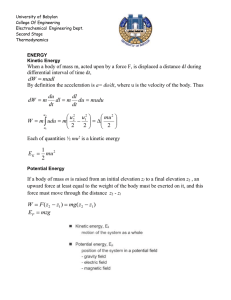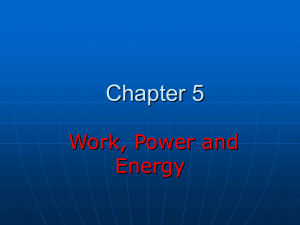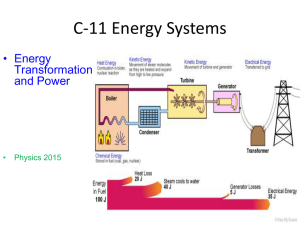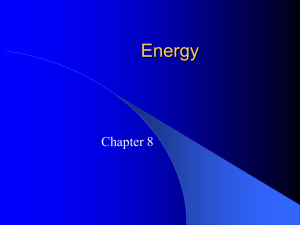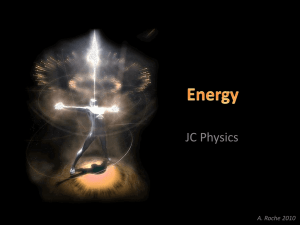As a meteor traveled through the atmosphere in October 1992, some
advertisement
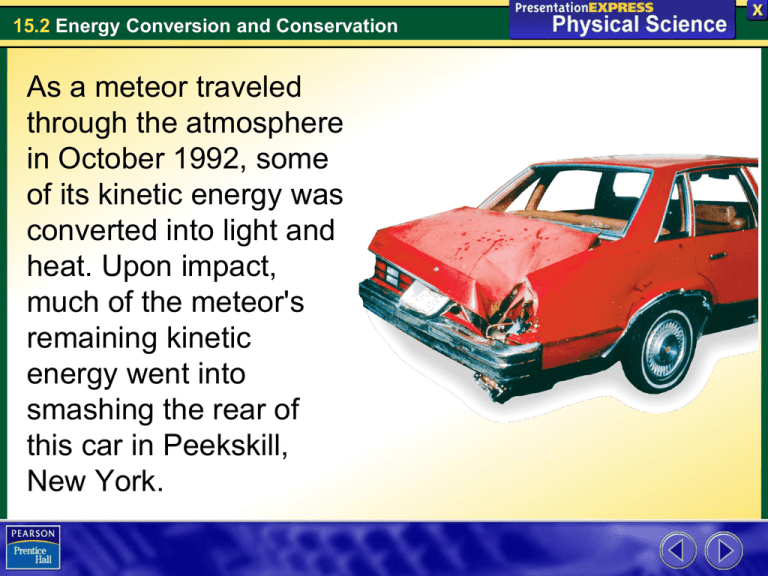
15.2 Energy Conversion and Conservation As a meteor traveled through the atmosphere in October 1992, some of its kinetic energy was converted into light and heat. Upon impact, much of the meteor's remaining kinetic energy went into smashing the rear of this car in Peekskill, New York. 15.2 Energy Conversion and Conservation Energy Conversion The process of changing energy from one form to another is _______________________________. •The striking of a match is a good example. –Muscles use chemical energy to move the match. –Friction between the match and the matchbox converts kinetic energy into thermal energy. –Chemical energy is converted into thermal energy and electromagnetic energy in the flame. 15.2 Energy Conversion and Conservation Conservation of Energy The law of conservation of energy states that energy cannot be created or destroyed. –When energy changes from one form to another, the total energy remains ___________, even though many energy conversions may occur. –In a closed system, the amount of energy present at the beginning of a process is the same as the amount of energy at the end. 15.2 Energy Conversion and Conservation The work done by friction changes kinetic energy into ________________________. • Friction reduces________and is a major cause of energy consumption in cars and factories. • In many cases, most of a falling object’s potential energy is converted into thermal energy because of air resistance. • Although speed skaters slide quickly over smooth ice, they are still slowed down by friction with the air and the surface of the ice. 15.2 Energy Conversion and Conservation Energy Conversions Gravitational potential energy of an object is converted to kinetic energy of motion as the object falls. One of the most common energy conversions is between___________energy and__________energy. • An avalanche brings tons of snow from the top of a mountain to the valley floor. • The elastic potential energy of a compressed spring is converted into kinetic energy as the spring expands. • Energy conversions can go from kinetic to potential energy or from potential to kinetic energy. 15.2 Energy Conversion and Conservation Energy Conversions Some gulls use energy conversion to obtain food by dropping oysters onto rocks. Kinetic energy causes the shell to break on collision with the rock. 15.2 Energy Conversion and Conservation A __________is a weight swinging back and forth from a rope or string. • At the highest point, a pendulum has 0 kinetic energy and max potential energy. • As the pendulum swings down, potential energy is converted to kinetic energy. • At the bottom of the swing, the pendulum has maximum kinetic energy and 0 potential energy. • The time it takes for a pendulum to swing back and forth once is precisely related to its length. • Pendulum clocks use pendulums to maintain accurate time. 15.2 Energy Conversion and Conservation In the pole vault, an athlete uses a flexible pole to propel over a high bar. • Some of the pole-vaulter’s kinetic energy is converted into_________potential energy as the pole bends. The pole springs back into shape, propelling the pole-vaulter upward. • As the pole-vaulter rises, kinetic energy decreases while he gains gravitational potential energy. • Once the highest point has been reached, gravitational potential energy begins to convert back to kinetic energy. 15.2 Energy Conversion and Conservation Energy Conversion Calculations •When friction is small enough to be ignored, and no mechanical energy is added to a system, then the system’s mechanical energy does not change. •Mechanical energy = KE + PE •The law of conservation of energy applies to any __________________process. •If friction can be neglected, the total mechanical energy remains __________________. 15.2 Energy Conversion and Conservation Energy Conversions Conservation of Mechanical Energy At a construction site, a 1.50-kg brick is dropped from rest and hits the ground at a speed of 26.0 m/s. Assuming air resistance can be ignored, calculate the gravitational potential energy of the brick before it was dropped. 15.2 Energy Conversion and Conservation Energy Conversions 1. A 10-kg rock is dropped and hits the ground below at a speed of 60 m/s. Calculate the gravitational potential energy of the rock before it was dropped. You can ignore the effects of friction. 15.2 Energy Conversion and Conservation Energy Conversions 2. A diver with a mass of 70.0 kg stands motionless at the top of a 3.0-m-high diving platform. Calculate his potential energy relative to the water surface while standing on the platform, and his speed when he enters the pool. (Hint: Assume the diver’s initial vertical speed after diving is zero.) 15.2 Energy Conversion and Conservation Energy Conversions 3. A pendulum with a 1.0-kg weight is set in motion from a position 0.04 m above the lowest point on the path of the weight. What is the kinetic energy of the pendulum at the lowest point? (Hint: Assume there is no friction.) 15.2 Energy Conversion and Conservation Albert Einstein developed his special theory of relativity in 1905. This theory included the now-famous equation________________. • E is energy, m is mass, and c is the speed of ___________. • The speed of light is extremely large: 3.0 × 108 m/s. • Energy is released as matter is destroyed and matter can be created from energy: energy and mass are equivalent. • A tiny amount of matter can produce an__________amount of energy. 15.2 Energy Conversion and Conservation Suppose 1 gram of matter were entirely converted into energy. E = mc2 = (10–3 kg) × (3 × 108 m/s) × (3 × 108 m/s) = 9 × 1013 kg•m2/s2 = 9 × 1013 J •1 gram of TNT produces only 2931 joules of energy. •In nuclear fission and fusion reactions, large amounts of energy are released by the destruction of very small amounts of matter. •The law of conservation of energy has been modified to say that mass and energy_______are always conserved.

